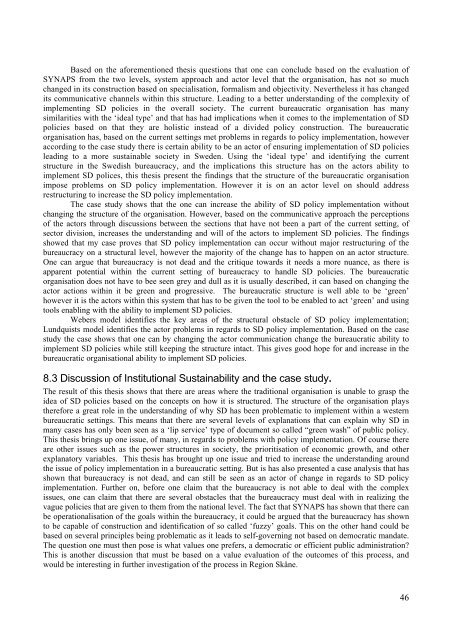From 'grey to green'- investigating the capabilities of the ... - lumes
From 'grey to green'- investigating the capabilities of the ... - lumes
From 'grey to green'- investigating the capabilities of the ... - lumes
Create successful ePaper yourself
Turn your PDF publications into a flip-book with our unique Google optimized e-Paper software.
Based on <strong>the</strong> aforementioned <strong>the</strong>sis questions that one can conclude based on <strong>the</strong> evaluation <strong>of</strong>SYNAPS from <strong>the</strong> two levels, system approach and ac<strong>to</strong>r level that <strong>the</strong> organisation, has not so muchchanged in its construction based on specialisation, formalism and objectivity. Never<strong>the</strong>less it has changedits communicative channels within this structure. Leading <strong>to</strong> a better understanding <strong>of</strong> <strong>the</strong> complexity <strong>of</strong>implementing SD policies in <strong>the</strong> overall society. The current bureaucratic organisation has manysimilarities with <strong>the</strong> ‘ideal type’ and that has had implications when it comes <strong>to</strong> <strong>the</strong> implementation <strong>of</strong> SDpolicies based on that <strong>the</strong>y are holistic instead <strong>of</strong> a divided policy construction. The bureaucraticorganisation has, based on <strong>the</strong> current settings met problems in regards <strong>to</strong> policy implementation, howeveraccording <strong>to</strong> <strong>the</strong> case study <strong>the</strong>re is certain ability <strong>to</strong> be an ac<strong>to</strong>r <strong>of</strong> ensuring implementation <strong>of</strong> SD policiesleading <strong>to</strong> a more sustainable society in Sweden. Using <strong>the</strong> ‘ideal type’ and identifying <strong>the</strong> currentstructure in <strong>the</strong> Swedish bureaucracy, and <strong>the</strong> implications this structure has on <strong>the</strong> ac<strong>to</strong>rs ability <strong>to</strong>implement SD polices, this <strong>the</strong>sis present <strong>the</strong> findings that <strong>the</strong> structure <strong>of</strong> <strong>the</strong> bureaucratic organisationimpose problems on SD policy implementation. However it is on an ac<strong>to</strong>r level on should addressrestructuring <strong>to</strong> increase <strong>the</strong> SD policy implementation.The case study shows that <strong>the</strong> one can increase <strong>the</strong> ability <strong>of</strong> SD policy implementation withoutchanging <strong>the</strong> structure <strong>of</strong> <strong>the</strong> organisation. However, based on <strong>the</strong> communicative approach <strong>the</strong> perceptions<strong>of</strong> <strong>the</strong> ac<strong>to</strong>rs through discussions between <strong>the</strong> sections that have not been a part <strong>of</strong> <strong>the</strong> current setting, <strong>of</strong>sec<strong>to</strong>r division, increases <strong>the</strong> understanding and will <strong>of</strong> <strong>the</strong> ac<strong>to</strong>rs <strong>to</strong> implement SD policies. The findingsshowed that my case proves that SD policy implementation can occur without major restructuring <strong>of</strong> <strong>the</strong>bureaucracy on a structural level, however <strong>the</strong> majority <strong>of</strong> <strong>the</strong> change has <strong>to</strong> happen on an ac<strong>to</strong>r structure.One can argue that bureaucracy is not dead and <strong>the</strong> critique <strong>to</strong>wards it needs a more nuance, as <strong>the</strong>re isapparent potential within <strong>the</strong> current setting <strong>of</strong> bureaucracy <strong>to</strong> handle SD policies. The bureaucraticorganisation does not have <strong>to</strong> bee seen grey and dull as it is usually described, it can based on changing <strong>the</strong>ac<strong>to</strong>r actions within it be green and progressive. The bureaucratic structure is well able <strong>to</strong> be ‘green’however it is <strong>the</strong> ac<strong>to</strong>rs within this system that has <strong>to</strong> be given <strong>the</strong> <strong>to</strong>ol <strong>to</strong> be enabled <strong>to</strong> act ‘green’ and using<strong>to</strong>ols enabling with <strong>the</strong> ability <strong>to</strong> implement SD policies.Webers model identifies <strong>the</strong> key areas <strong>of</strong> <strong>the</strong> structural obstacle <strong>of</strong> SD policy implementation;Lundquists model identifies <strong>the</strong> ac<strong>to</strong>r problems in regards <strong>to</strong> SD policy implementation. Based on <strong>the</strong> casestudy <strong>the</strong> case shows that one can by changing <strong>the</strong> ac<strong>to</strong>r communication change <strong>the</strong> bureaucratic ability <strong>to</strong>implement SD policies while still keeping <strong>the</strong> structure intact. This gives good hope for and increase in <strong>the</strong>bureaucratic organisational ability <strong>to</strong> implement SD policies.8.3 Discussion <strong>of</strong> Institutional Sustainability and <strong>the</strong> case study.The result <strong>of</strong> this <strong>the</strong>sis shows that <strong>the</strong>re are areas where <strong>the</strong> traditional organisation is unable <strong>to</strong> grasp <strong>the</strong>idea <strong>of</strong> SD policies based on <strong>the</strong> concepts on how it is structured. The structure <strong>of</strong> <strong>the</strong> organisation plays<strong>the</strong>refore a great role in <strong>the</strong> understanding <strong>of</strong> why SD has been problematic <strong>to</strong> implement within a westernbureaucratic settings. This means that <strong>the</strong>re are several levels <strong>of</strong> explanations that can explain why SD inmany cases has only been seen as a ‘lip service’ type <strong>of</strong> document so called “green wash” <strong>of</strong> public policy.This <strong>the</strong>sis brings up one issue, <strong>of</strong> many, in regards <strong>to</strong> problems with policy implementation. Of course <strong>the</strong>reare o<strong>the</strong>r issues such as <strong>the</strong> power structures in society, <strong>the</strong> prioritisation <strong>of</strong> economic growth, and o<strong>the</strong>rexplana<strong>to</strong>ry variables. This <strong>the</strong>sis has brought up one issue and tried <strong>to</strong> increase <strong>the</strong> understanding around<strong>the</strong> issue <strong>of</strong> policy implementation in a bureaucratic setting. But is has also presented a case analysis that hasshown that bureaucracy is not dead, and can still be seen as an ac<strong>to</strong>r <strong>of</strong> change in regards <strong>to</strong> SD policyimplementation. Fur<strong>the</strong>r on, before one claim that <strong>the</strong> bureaucracy is not able <strong>to</strong> deal with <strong>the</strong> complexissues, one can claim that <strong>the</strong>re are several obstacles that <strong>the</strong> bureaucracy must deal with in realizing <strong>the</strong>vague policies that are given <strong>to</strong> <strong>the</strong>m from <strong>the</strong> national level. The fact that SYNAPS has shown that <strong>the</strong>re canbe operationalisation <strong>of</strong> <strong>the</strong> goals within <strong>the</strong> bureaucracy, it could be argued that <strong>the</strong> bureaucracy has shown<strong>to</strong> be capable <strong>of</strong> construction and identification <strong>of</strong> so called ‘fuzzy’ goals. This on <strong>the</strong> o<strong>the</strong>r hand could bebased on several principles being problematic as it leads <strong>to</strong> self-governing not based on democratic mandate.The question one must <strong>the</strong>n pose is what values one prefers, a democratic or efficient public administration?This is ano<strong>the</strong>r discussion that must be based on a value evaluation <strong>of</strong> <strong>the</strong> outcomes <strong>of</strong> this process, andwould be interesting in fur<strong>the</strong>r investigation <strong>of</strong> <strong>the</strong> process in Region Skåne.46
















